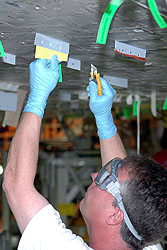Priority given to protecting high-risk areas of Discovery tiling in preparation for lift-off
Space Shuttle Discovery will not have redesigned gapfillers installed between all 15,000 thermal protection system (TPS) tiles before mission STS 121’s expected May launch.
The gapfillers are like playing cards and were originally bonded into position using a needle. The use of the needle led to incorrect adhesive application, giving a weak bond between tile and card.
|
| Engineers removing adhesive fabric to insert gapfiller "card" between TPS tiles |
Protruding filler could be a source of debris and causes turbulence in the airflow, which results in potentially dangerous localised heating on re-entry. During Discovery’s last mission, STS 114, two gapfillers protruded 25mm (1in) between tiles and were removed during a spacewalk.
Installing the new gapfillers is “a major undertaking”, says Boeing TPS subsystem manager Dan Bell. “We prioritised the areas of highest risk. We are working those sequentially. Will we get all [20,000] finished? It’s unlikely if there is a May launch.”
The new process uses an adhesive release fabric. The card is inserted, the fabric removed and then the adhesive cures.
The filler cards are now longer, with three holes in one end to which a 5kg (11lb) mass is attached to test the bonding strength. After the test, the excess card is trimmed.
Boeing, NASA and Shuttle launch provider United Space Alliance started developing a solution to gapfiller protuberance during the STS 114 mission.
Installation work started on Discovery in November. Shuttle Atlantis is also having its gapfillers changed out because it will be the standby orbiter if Discovery’s crew needs rescuing.
ROB COPPINGER / LONDON
Source: Flight International
























